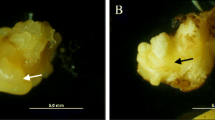Abstract
Phenylalanine ammonia-lyase (PAL) activity, contents of phenolic acids and ethylene production during the lag-phase, and contents of phenolic acids at the late exponential phase, showed significant differences in embryogenic (EC) and non-embryogenic (NEC) suspension cultures of Medicago sativa L. Maximum PAL activity at 6 h after inoculation was followed by an increase in the level of phenolic acids from 9.6 μg g−1 fresh mass to 21 μg g−1 fresh mass in NEC at 12 h. Thereafter the level of phenolic acids decreased to 5.2 μg g−1 fresh mass at 72 h. The decline was caused predominantly by the decrease of ester-bound cinnamic acid derivatives, the decrease ranging from 83 to 20% of total phenolics. Two maxima of ethylene production were observed in NEC: the first one immediately after inoculation and the second at 6 h, coinciding with the peak of PAL activity. In NEC, most of the phenolic acids occurred in esterified form. Ability to form somatic embryos (EC) was associated with the absence of the second peak of ethylene production as well as of the peak of PAL activity at 6 h. The level of phenolic acids during the lag-phase remained low (7.2 μg g−1 FM) and did not change. The proportion of cinnamic acid derivatives was very low (18% of total phenolics), mostly due to the extremely low level of ferulic acid. In EC, phenolic acids bound to methanol insoluble material formed the major fraction. Loss of embryogenic potential of the embryogenic culture (ECL) was associated with qualitative and quantitative changes in the contents of phenolic acids insignificantly increased PAL activity after inoculation was followed by a moderate increase in the contents of phenolic acids from 9.35 μg g−1 fresh mass to 12.42 μg g fresh mass. A high rate of ethylene production was observed only immediately after the transfer of the culture to fresh medium. The loss of embryogenicity correlated also with changes in the relative amounts of the investigated fractions of phenolic acids. A distinct increase in the level of methoxy-substituted phenolic acids is a characteristic feature of the ECL culture.
Similar content being viewed by others
Abbreviations
- NEC:
-
non-embryogenic suspension culture
- EC:
-
embryogenic suspension culture
- ECL:
-
embryogenic suspension culture after the loss of embryogenic potential
- AA:
-
anisic acid
- CA:
-
cinnamic acid
- CaA:
-
caffeic acid
- pCA:
-
p-coumaric acid
- FA:
-
ferulic acid
- pHBA:
-
p-hydroxybenzoic acid
- SA:
-
syringic acid
- SaA:
-
salicylic acid
- SiA:
-
sinapic acid
- VA:
-
vanillic acid
- PhA:
-
phenolic acids
- HPLC:
-
High-Performance Liquid Chromatography
- GC:
-
Gas Chromatography
- 2,4-D:
-
2,4-dichlorophenoxyacetic acid
- kin:
-
kinetin
- NAA:
-
1-naphthaleneacetic acid
- BL-medium:
-
medium of Blaydess
- FM:
-
fresh mass
References
Binarová P. Doležel J (1988) J. Plant Physiol. 133:561–566
Blaydess JF (1966) Physiol. Plant 19:748–753
Boller T (1983) In: Bangerth F (ed) Regulation des Phytohormongehaltes und seine Beeinflussung durch synthetische Wachstumsresulatoren. Hohenheimer Arbeiten, Reihe Pflanzliche Produktion 129:167–189
Chen LJ, Luthe DS (1987) Plant Sci. 48:181–188
Chibbar RN, Shyiuk J, Georges F. Mallard CS, Constabel F (1988) J. Plant Physiol. 133:367–370
Choi JH, Sung ZR (1989) In: Kung SD, Arntzen CJ (eds) Plant Biotechnology, Butterworths, Boston pp. 141–159
Cvikrová M, Hrubcová M, Meravý L, Pospišil F (1988) Biol. Plant. 30:185–192
Cvikrová M, Meravý L, Hrubcová M, Eder J (1990) Biol. Plant. 32:161–170
Feirer RP, Mignon C, Litvay JD (1984) Science 223:1433–1435
Fransz PF, de Ruijter NCA, Schell JHN (1989) Plant Cell Rep. 8:67–70
Fry LC (1983) Planta 157:111–123
Hahlbrock K, Schröder J (1975) Arch. Biochem. Biophys. 171:500–506
Hahlbrock K, Schröder J, Vieregge J (1981) In: Fiechter A (ed) Plant Cell Culture II Akademie-Verlag, Berlin pp. 39–60
Jangaard NO (1974) Phytochemistry 13:1765–1768
Kamada H, Harada H (1984) Biochem. Physiol. Pflanzen 179:403–410
Kikuta Y, Masuda IC, Okazava Y (1981) J. of the Faculty of Agricult., Hokkaido Univ. 60:249–262
Lowry OH, Rosebrough NJ, Farr AL, Randall RJ (1951) J. Biol. Chem. 193:265–275
Meravý L (1979) Biol. Plant 21:427–433
Meravý L, Macháčková I, Cvikrová M, Eder J (1991) Plant Physiol. Biochem. 29:in press
Noland TL, Feirer RP, Phytyon JR (1986) Plant Physiol. 80:112
Rasol MK, Jelaska S, Šerman D (1982) Acta Bot. Croat. 41:33–39
Roustan JP, Latche A, Fallot J (1990) Biol. Plant. 32:273–276
Songstad DD, Petracek PD, Sams CE, Conger BV (1989) Plant Cell Rep. 7:677–679
Tisserat B, Murashige T (1977) Plant Physiol. 60:437–439
Wann SR, Johnson MA, Noland TL, Carlson JA (1987) Plant Cell Rep. 6:39–42
Yamakawa T, Kato S, Ishida K, Kodama T, Minoda Y (1983) Agric. Biol. Chem. 47:2185–2191
Zador E, Köves E, Szabó M (1985) Biochem. Physiol. Pflanzen 180:125–131
Author information
Authors and Affiliations
Additional information
Communicated by N. Amrhein
Rights and permissions
About this article
Cite this article
Cvikrová, M., Meravý, L., Macháčková, I. et al. Phenylalanine ammonia-lyase, phenolic acids and ethylene in alfalfa (Medicago sativa L.) cell cultures in relation to their embryogenic ability. Plant Cell Reports 10, 251–255 (1991). https://doi.org/10.1007/BF00232569
Received:
Revised:
Issue Date:
DOI: https://doi.org/10.1007/BF00232569



